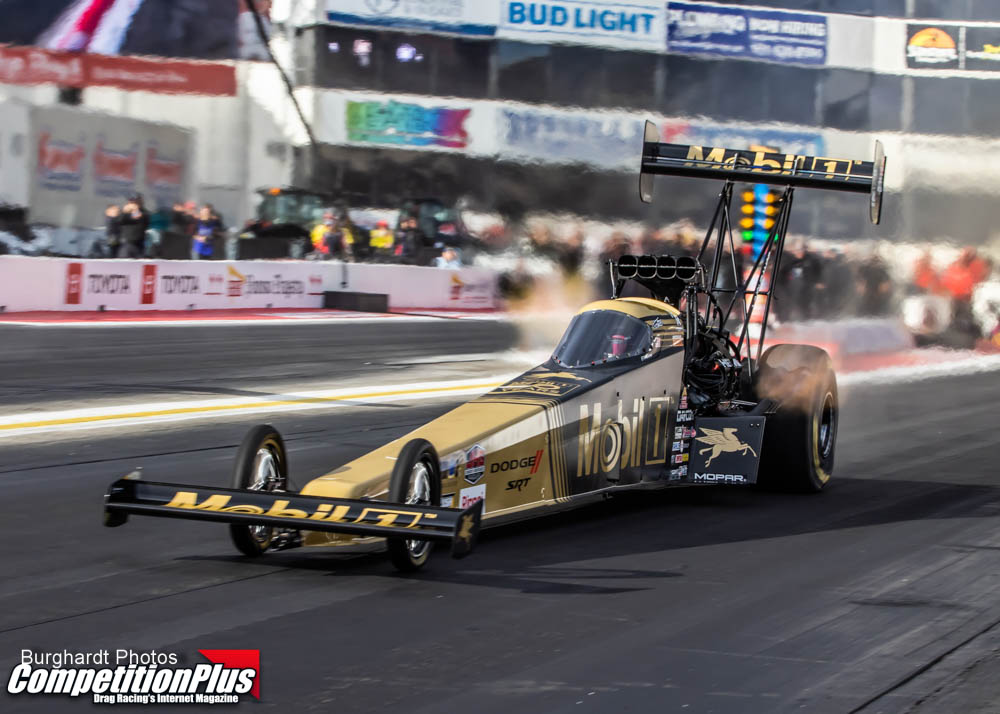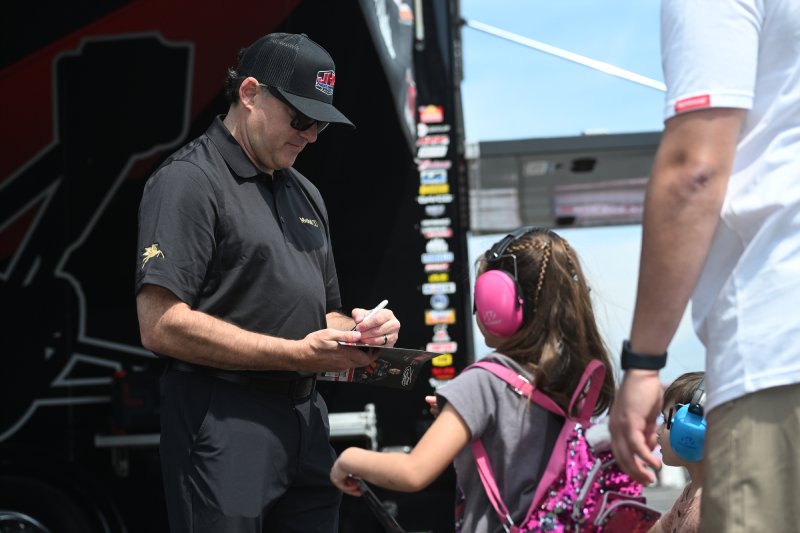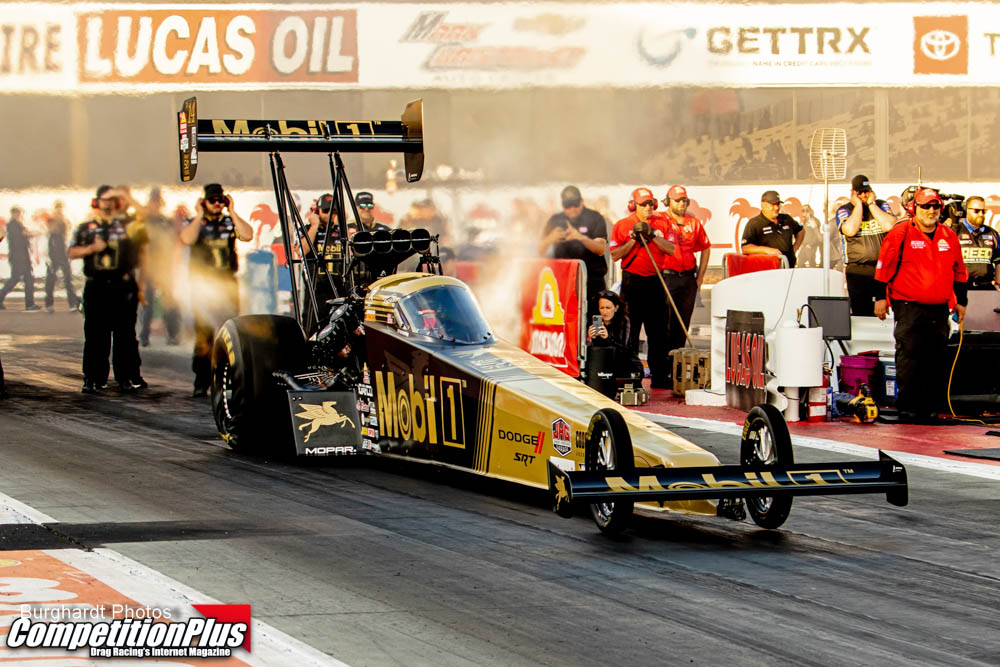TONY STEWART GETS CANDID ON HIS DRAG RACING

 Tony Stewart said during a break at this past weekend’s Lucas Oil Winternationals at Southern California’s In-N-Out Burger Pomona Dragstrip that it’s too early to be an expert on all the nuances of his Top Fuel dragster. And he claims he isn’t partial to one kind of race car, despite his love for dirt cars.
Tony Stewart said during a break at this past weekend’s Lucas Oil Winternationals at Southern California’s In-N-Out Burger Pomona Dragstrip that it’s too early to be an expert on all the nuances of his Top Fuel dragster. And he claims he isn’t partial to one kind of race car, despite his love for dirt cars.
But he is certain that he never will become a Funny Car driver. And he’s adamant that his spin in an 11,000-horsepower, nitro-gulping Top Fuel has a limited run, at least for the immediate future. He stepped in as a substitute this season for wife Leah Pruett, who announced in December she would step from the cockpit to focus on starting a family.
“Listen,” Stewart said, “I was just hoping I was still going to have a job after Gainesville,” where he qualified ninth and bowed out in the first round of eliminations at the Florida season-opener two weeks ago.
“I think if you asked Leah, she’s got a different idea than what I have, but literally on my radar right now, I’m just driving this car until she’s ready to come back. As soon as she’s ready to come back, I’m going to get out of her race car. I don’t care if it has my name on it. I don’t care if the trailer has my name on it. That’s her race car. That’s her race team over there,” he said.
“Get another one for yourself,” someone suggested. “I’ll start a GoFundMe account,” Stewart joked. “It just takes money.”
He said it’s “maybe too early” to compare the Top Fuel dragster to the Top Alcohol Dragster in which he started, but identified the thrust and the speed as two definite factors.
“Obviously, it leaves [the starting line] harder. It doesn’t leave that much harder than the fuel car, but it just continuously pulls. It’s just a way different feeling when you hit the gas,” Stewart said. “At least to this point, through where I’m at right now, the driving part’s pretty similar. But you just know that if you have to start moving the pedal around that, it can get expensive and ugly really fast if it doesn’t work.”
The dragster, he said, “steers like an IndyCar, basically. The way the steering ratios are and everything and as far as how much you move the wheel for small corrections, that part’s very similar.”
His Tony Stewart Racing teammate is Matt Hagan, the four-time and reigning Funny Car champion. He made a pass in Hagan’s car at Indianapolis Raceway Park last year and promised it would be his last — not that he ever wanted a first crack at it.
“I can tell you from going to that car [the Top Fuel dragster] last year and running Matt’s car at IRP last year; a Funny Car is like driving a winged sprint car. But it’s like sliding the wing all the way back to the trunk. When I drove that the first run, it washed out and pointed me out through the wall, and I just didn’t steer it enough. But I steered it like I would a dragster.”
 After his Funny Car experience, he said he has decided he’s “probably better suited” for the Top Fuel car.
After his Funny Car experience, he said he has decided he’s “probably better suited” for the Top Fuel car.
A year ago, for Christmas, he and Pruett gave Stewart’s father a day at Frank Hawley’s Drag Racing School in Gainesville, Fla. He got a tutorial from Hawley and simply made laps all day. So he decided, “If I’m going to be there all day and got to watch, I might as well drive something. I’ll see if I can drive Frank’s car. And if I can’t do it, I can’t do it, and there won’t be anybody there, and it won’t be that embarrassing.’ So I made four or five runs in it there. It’s like, ‘I know I might be able to do this,’ and I tried. I only committed to doing one day and I served my time. I’m done.”
He hasn’t always had complete confidence in his commitment to drive the dragster, either.
Musing that “I tend to make bad decisions,” Stewart said, “Trust me, there were a lot of nights and a lot of mornings after I had shoulder surgery and I’m recuperating in a recliner at the ranch and I’d wake up in the morning going, ‘What did I sign myself up for?’” However, he quickly clarified, “I don’t regret it.”
That makes him braver than any of his NASCAR or dirt-track buddies. Not one of them he said, has an interest in trying out drag racing.
“None of ’em. None of ’em,” he said. “And they all think I’ve lost my mind. That’s the funniest part. It’s like they all think I’m insane now. So I’m like, ‘You guys knew that before I left sprint-car racing and stock-car racing.’”
One huge difference Stewart said he has noticed between NASCAR and NHRA competition is the cadence of the adrenaline rush, the flow of race day.
“It’s different. It’s way different,” he said. “I think the main reason for that is a sprint-car race at Williams Grove, for example, is going to be a 25- or 30-lap main. If you can pull a corner, you got multiple laps to make it up. And here, anything goes wrong – if I do something wrong, if the car does something wrong – I mean, you’re one and done. So you don’t have the opportunity to go, ‘OK, we’ll scrap this and the next lap we’ll fix it.’ So I think that’s where the adrenalin side comes and peaks a little higher, just because the stakes are higher.
“You get in the car at Martinsville or Bristol and your heart rate doesn’t even get up hardly. You’re going to be in there for three and a half hours. You’re going to have pit stops. You’re going to have all kinds of stuff go on, and the whole complexion of the race is constantly going to evolve ... where here, it’s in a four-second window that whatever’s going to happen is going to happen and it’s either going to go right or it doesn’t go right,” he said.
“When you’re in the Cup car and you start to race, the adrenalin’s there and it’s up there for three-and-a-half straight hours, where when you’re here, it’s up for the run and when you come back, then you lose that adrenaline. And then it comes back up when you run the next time. Well, if you do that, if you make it to the finals on Sunday and you’ve gone through that cycle, you physically are exhausted and mentally exhausted because of the peaks and valleys,” he said. “Truly, I feel like that’s one of the biggest aspects of this that people don’t realize, how adrenalin affects your body. They know what it does when it comes up, but they don’t realize the backside of the cycle and your mood cycle.
“I wouldn’t say I’m more exhausted, but it’s a different curve. If you run all four rounds on Sunday and it goes down all four rounds, you’re going to drive the car literally less than 16 seconds. You get out of a car where you’ve run 500 miles and you feel exactly the same. It’s like, ‘How can you feel that tired? And what is it, less than three miles that you’re driving in these cars?’” he said. “It’s the adrenaline side of it and how it builds up and then it comes down when you come back to the pit and it builds up, comes back down. It doesn’t do that in the Cup car. You kind of get up there and I don’t think you get quite as high, but you get up there and you just kind of level off and maintain for the whole day.”







































